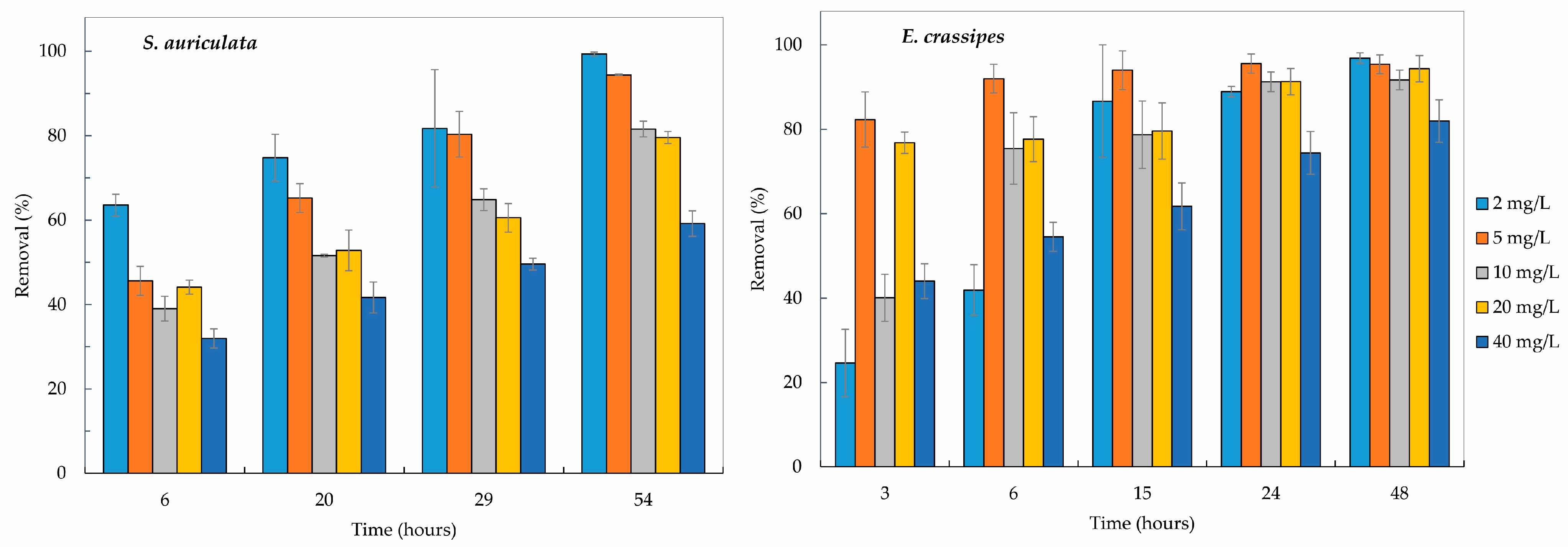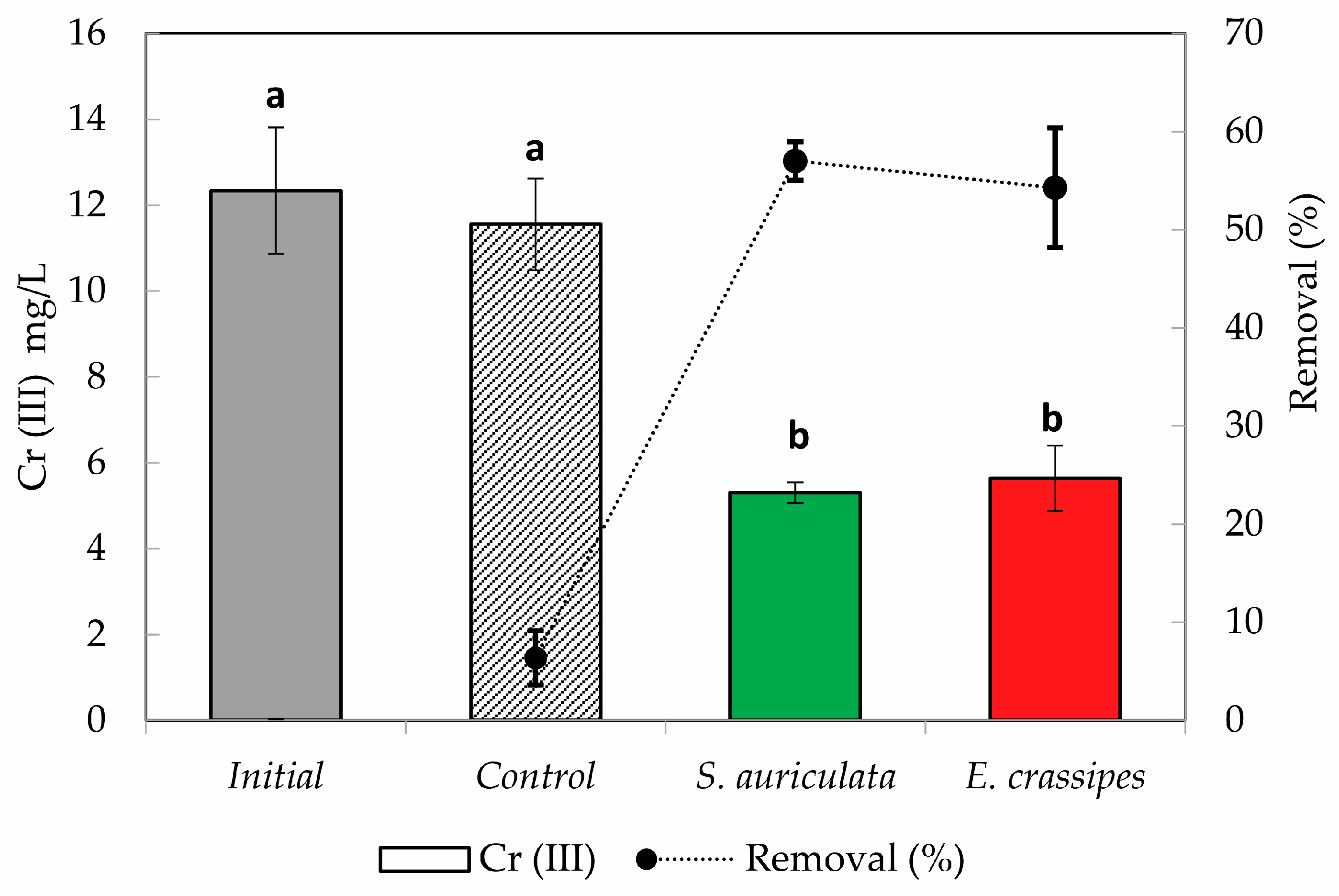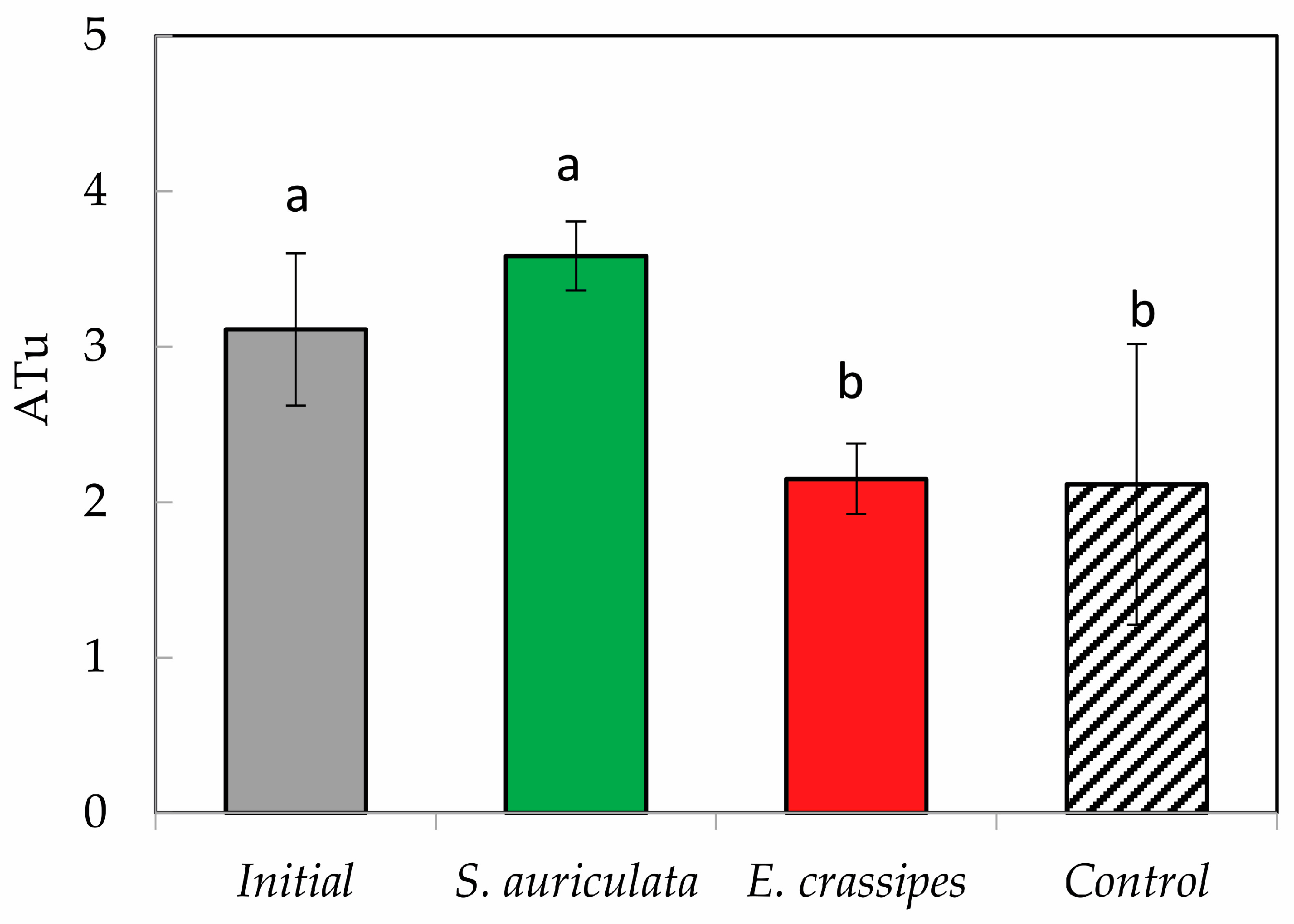Removal of Chromium (III) and Reduction in Toxicity in a Primary Tannery Effluent Using Two Floating Macrophytes
Abstract
:1. Introduction
2. Materials and Methods
2.1. Plant Specimen Collection, Experimental Conditions of Phytosorption Assays, and Removal of Cr(III)
2.2. Phytoremediation of Tannery Effluent in Floating Wetlands with E. crassipes and S. auriculata
2.3. Chromium Analysis and Physicochemical Parameters of the Tannery Primary Effluent
2.4. Bioassays
2.4.1. Toxicity Assay with Daphnia magna
2.4.2. Micronucleus Test in Danio rerio
2.4.3. Statistical Data Analysis
3. Results and Discussion
3.1. Removal and Accumulation of Chromium (III) in Nutrient Solution and BAF
3.2. Chromium (III) Phytoremediation and Tannery Effluent Toxicity
3.3. Toxicity Assays
3.3.1. Toxicity Assay with Daphnia magna
3.3.2. Toxicity Assays with Danio rerio
4. Conclusions
Author Contributions
Funding
Institutional Review Board Statement
Informed Consent Statement
Data Availability Statement
Acknowledgments
Conflicts of Interest
References
- Nedjimi, B. Phytoremediation: A Sustainable Environmental Technology for Heavy Metals Decontamination. SN Appl. Sci. 2021, 3, 286. [Google Scholar] [CrossRef]
- Kimbrough, D.E.; Cohen, Y.; Winer, A.M.; Creelman, L.; Mabuni, C. A Critical Assessment of Chromium in the Environment. Crit. Rev. Environ. Sci. Technol. 1999, 29, 1–46. [Google Scholar] [CrossRef]
- Shrivastava, H.Y.; Ravikumar, T.; Shanmugasundaram, N.; Babu, M.; Unni Nair, B. Cytotoxicity Studies of Chromium(III) Complexes on Human Dermal Fibroblasts. Free Radic. Biol. Med. 2005, 38, 58–69. [Google Scholar] [CrossRef]
- Fang, Z.; Zhao, M.; Zhen, H.; Chen, L.; Shi, P.; Huang, Z. Genotoxicity of Tri- and Hexavalent Chromium Compounds in Vivo and Their Modes of Action on DNA Damage in Vitro. PLoS ONE 2014, 9, e103194. [Google Scholar] [CrossRef]
- Bhardwaj, A.; Kumar, S.; Singh, D. Tannery Effluent Treatment and Its Environmental Impact: A Review of Current Practices and Emerging Technologies. Water Qual. Res. J. 2023, 58, 128–152. [Google Scholar] [CrossRef]
- Medina, L.; Ferreira, F.P.; Kurita-Oyamada, G.; Rodriguez Bonet, S.; Galeano, E.F.; Viera, M.R. Fitorremediación de Cromo En Efluente de Curtiembre Empleando Eichhornia crassipes. Reportes Científicos la FACEN 2019, 10, 25–36. [Google Scholar]
- Famielec, S. Chromium Concentrate Recovery from Solid Tannery Waste in a Thermal Process. Materials 2020, 13, 1533. [Google Scholar] [CrossRef] [PubMed]
- UNIDO. The Scope for Decreasing Pollution Load in Leather Processing (US/RAS/92/120/11-51); United Nations Industrial Development Organization, Regulatory Programming Pollution Control Tannery Industrial South-East Asia: Vienna, Austria, 2000; pp. 1–36. [Google Scholar]
- Gupta, K.; Gaumat, S.; Mishra, K. Studies on Phyto-Genotoxic Assessment of Tannery Effluent and Chromium on Allium cepa. J. Environ. Biol. 2012, 33, 557–563. [Google Scholar] [PubMed]
- Weldetinsae, A.; Dawit, M.; Getahun, A.; Patil, H.S.; Alemayehu, E.; Gizaw, M.; Abate, M.; Abera, D. Aneugenicity and Clastogenicity in Freshwater Fish Oreochromis niloticus Exposed to Incipient Safe Concentration of Tannery Effluent. Ecotoxicol. Environ. Saf. 2017, 138, 98–104. [Google Scholar] [CrossRef] [PubMed]
- Pavlidis, G.; Zotou, I.; Karasali, H.; Marousopoulou, A.; Bariamis, G.; Nalbantis, I.; Tsihrintzis, V.A. Experiments on Pilot-Scale Constructed Floating Wetlands Efficiency in Removing Agrochemicals. Toxics 2022, 10, 790. [Google Scholar] [CrossRef] [PubMed]
- Stefanakis, A.; Akratos, C.S.; Tsihrintzis, V.A. Vertical Flow Constructed Wetlands: Eco-Engineering Systems for Wastewater and Sludge Treatment; Newnes: Oxford UK; Boston, MA, USA, 2014; pp. 1–16. [Google Scholar] [CrossRef]
- Kadlec, R.; Wallace, S. Treatment Wetlands, 2nd ed.; CRC Press: Boca Raton, FL, USA, 2009. [Google Scholar]
- Kassaye, G.; Gabbiye, N.; Alemu, A. Phytoremediation of Chromium from Tannery Wastewater Using Local Plant Species. Water Pract. Technol. 2017, 12, 894–901. [Google Scholar] [CrossRef]
- Zayed, A.; Gowthaman, S.; Terry, N. Phytoaccumulation of Trace Elements by Wetland Plants: I. Duckweed. J. Environ. Qual. 1998, 27, 715–721. [Google Scholar] [CrossRef]
- Younas, F.; Niazi, N.K.; Bibi, I.; Afzal, M.; Hussain, K.; Shahid, M.; Aslam, Z.; Bashir, S.; Hussain, M.M.; Bundschuh, J. Constructed Wetlands as a Sustainable Technology for Wastewater Treatment with Emphasis on Chromium-Rich Tannery Wastewater. J. Hazard. Mater. 2022, 422, 126926. [Google Scholar] [CrossRef]
- Hasan, S.M.M.; Akber, M.A.; Bahar, M.M.; Islam, M.A.; Akbor, M.A.; Siddique, M.A.B.; Islam, M.A. Chromium Contamination from Tanning Industries and Phytoremediation Potential of Native Plants: A Study of Savar Tannery Industrial Estate in Dhaka, Bangladesh. Bull. Environ. Contam. Toxicol. 2021, 106, 1024–1032. [Google Scholar] [CrossRef] [PubMed]
- Maine, M.A.; Suñe, N.; Hadad, H.; Sánchez, G.; Bonetto, C. Removal Efficiency of a Constructed Wetland for Wastewater Treatment According to Vegetation Dominance. Chemosphere 2007, 68, 1105–1113. [Google Scholar] [CrossRef] [PubMed]
- Oyuela Leguizamo, M.A.; Fernández Gómez, W.D.; Sarmiento, M.C.G. Native Herbaceous Plant Species with Potential Use in Phytoremediation of Heavy Metals, Spotlight on Wetlands—A Review. Chemosphere 2017, 168, 1230–1247. [Google Scholar] [CrossRef] [PubMed]
- Miranda, C.V.; Schwartsburd, P.B. Salvinia (Salviniaceae) in Southern and Southeastern Brazil—Including New Taxa, New Distribution Records, and New Morphological Characters. Rev. Bras. Bot. 2019, 42, 171–188. [Google Scholar] [CrossRef]
- Mereles, F.; De Egea Elsam, J.; Céspedes, G.; Peña-Chocarro, M.d.C.; Degen de Arrua, R. Plantas Acuáticas y Palustres Del Paraguay; Facultad de Ciencias Químicas: San Lorenzo, Paraguay, 2015; Volume 1. [Google Scholar]
- Heneidy, S.Z.; Halmy, M.W.A.; Fakhry, A.M.; El-Makawy, A.M. The Status and Potential Distribution of Hydrocotyle Umbellata, L. and Salvinia Auriculata Aubl. under Climate Change Scenarios. Aquat. Ecol. 2019, 53, 509–528. [Google Scholar] [CrossRef]
- Lozano, V. Distribution of Five Aquatic Plants Native to South America and Invasive Elsewhere under Current Climate. Ecologies 2021, 2, 27–42. [Google Scholar] [CrossRef]
- Liu, D.; Wang, R.; Gordon, D.R.; Sun, X.; Chen, L.; Wang, Y. Predicting Plant Invasions Following China’s Water Diversion Project. Environ. Sci. Technol. 2017, 51, 1450–1457. [Google Scholar] [CrossRef]
- Zimmels, Y.; Kirzhner, F.Ã.; Malkovskaja, A. Application of Eichhornia crassipes and Pistia stratiotes for Treatment of Urban Sewage in Israel. J. Environ. Manag. 2006, 81, 420–428. [Google Scholar] [CrossRef] [PubMed]
- Mishra, V.K.; Tripathi, B.D. Accumulation of Chromium and Zinc from Aqueous Solutions Using Water Hyacinth (Eichhornia crassipes). J. Hazard. Mater. 2009, 164, 1059–1063. [Google Scholar] [CrossRef]
- Mohanty, K.; Jha, M.; Meikap, B.C.; Biswas, M.N. Biosorption of Cr(VI) from Aqueous Solutions by Eichhornia crassipes. Chem. Eng. J. 2006, 117, 71–77. [Google Scholar] [CrossRef]
- Taylor, P.; Journal, B.; Akinbile, C.O.; Yusoff, M.S.; Shian, L.M.; Yusoff, M.S.; Shian, L.M. Leachate Characterization and Phytoremediation Using Water Hyacinth ( Eichorrnia crassipes ) in Pulau Burung, Malaysia. Bioremediat. J. 2012, 16, 37–41. [Google Scholar] [CrossRef]
- Ebel, M.; Evangelou, M.W.H.; Schaeffer, A. Cyanide Phytoremediation by Water Hyacinths (Eichhornia crassipes). Chemosphere 2007, 66, 816–823. [Google Scholar] [CrossRef]
- Woldemichael, D.; Zewge, F.; Leta, S. Potential of Water Hyacinth (Eichhornia crassipes (Mart.) Solms) for the Removal of Chromium from Tannery Efluent in Constructed Pond System. Ethiop. J. Sci. 2011, 34, 49–62. [Google Scholar]
- Molisani, M.M.; Rocha, R.; Machado, W.; Barreto, R.C.; Lacerda, L.D. Mercury Contents in Aquatic Macrophytes from Two Reservoirs in the Paraíba Do Sul: Guandú River System, SE Brazil. Brazilian J. Biol. 2006, 66, 101–107. [Google Scholar] [CrossRef]
- Espinoza-Quiñones, F.R.; Da Silva, E.A.; De Almeida Rizzutto, M.; Palácio, S.M.; Módenes, A.N.; Szymanski, N.; Martin, N.; Kroumov, A.D. Chromium Ions Phytoaccumulation by Three Floating Aquatic Macrophytes from a Nutrient Medium. World J. Microbiol. Biotechnol. 2008, 24, 3063–3070. [Google Scholar] [CrossRef]
- Ponce, S.C.; Prado, C.; Pagano, E.; Prado, F.E.; Rosa, M. Effect of PH on Cr(III) Accumulation, Biomass Production, and Phenolic Profile in 2 Salvinia Species. Environ. Toxicol. Chem. 2019, 38, 167–176. [Google Scholar] [CrossRef] [PubMed]
- Olguín, E.J.; Hernández, E.; Ramos, I. The Effect of Both Different Light Conditions and the PH Value on the Capacity of Salvinia minima BAKER for Removing Cadmium, Lead and Chromium. Acta Biotechnol. 2002, 22, 121–131. [Google Scholar] [CrossRef]
- Singh, A.; Kumar, S.; Panghal, V. Adsorption of Chromium (Cr6+) on Dead Biomass of Salvinia molesta (Kariba Weed) and Typha Latifolia (Broadleaf cattail): Isotherm, Kinetic, and Thermodynamic Study. Appl. Water Sci. 2021, 11, 149. [Google Scholar] [CrossRef]
- Oliveira, J.C.G.; de Moraes Ferreira, R.; Stapelfeldt, D.M.A. Use of Salvinia sp on the Adsorption of Hexavalent Chromium. Environ. Sci. Pollut. Res. 2019, 26, 30463–30471. [Google Scholar] [CrossRef] [PubMed]
- Bolognesi, C.; Perrone, E.; Roggieri, P.; Pampanin, D.; Sciutto, A. Assesment of Micronuclei Induction in Pheripheral Erythrocytes of Fish Exposed to Xenobiotics under Controlled Conditions. Aquat. Toxicol. 2006, 78, 93–98. [Google Scholar] [CrossRef] [PubMed]
- Chagas, T.Q.; Da, G.; Alvarez, S.; Flores Montalvão, M.; Mesak, C.; Lopes Rocha, T.; Pereira Da Costa Araújo, A.; Malafaia, G. Behavioral Toxicity of Tannery Effluent in Zebrafish (Danio rerio) Used as Model System. Sci. Total Environ. 2019, 685, 923–933. [Google Scholar] [CrossRef] [PubMed]
- Shaw, P.; Mondal, P.; Bandyopadhyay, A.; Chattopadhyay, A. Environmentally Relevant Concentration of Chromium Induces Nuclear Deformities in Erythrocytes and Alters the Expression of Stress-Responsive and Apoptotic Genes in Brain of Adult Zebrafish. Sci. Total Environ. 2020, 703, 135622. [Google Scholar] [CrossRef] [PubMed]
- De Nicola, E.; Meriç, S.; Della Rocca, C.; Gallo, M.; Iaccarino, M.; Manini, P.; Petruzzelli, D.; Belgiorno, V.; Cheggour, M.; Di Gennaro, A.; et al. Wastewater Toxicity of Tannin- versus Chromium-Based Leather Tanneries in Marrakesh, Morocco. Arch. Environ. Contam. Toxicol. 2007, 53, 321–328. [Google Scholar] [CrossRef] [PubMed]
- de Souza Celente, G.; Colares, G.S.; da Silva Araújo, P.; Machado, Ê.L.; Lobo, E.A. Acute Ecotoxicity and Genotoxicity Assessment of Two Wastewater Treatment Units. Environ. Sci. Pollut. Res. 2020, 27, 10520–10527. [Google Scholar] [CrossRef] [PubMed]
- Tabinda, A.B.; Irfan, R.; Yasar, A.; Iqbal, A.; Mahmood, A. Phytoremediation Potential of Pistia stratiotes and Eichhornia crassipes to Remove Chromium and Copper. Environ. Technol. 2020, 41, 1514–1519. [Google Scholar] [CrossRef]
- Singh, G.; Sinha, A. Phytoremediation of Chromium(VI)-Laden Waste by Eichhornia crassipes. Int. J. Environ. Technol. Manag. 2011, 14, 33–42. [Google Scholar] [CrossRef]
- Schwantes, D.; Gonçalves, A.C., Jr.; Schiller, A.D.P.; Manfrin, J.; Campagnolo, M.A.; Veiga, T.G. Salvinia auriculata in Post-Treatment of Dairy Industry Wastewater. Int. J. Phytoremediat. 2019, 21, 1368–1374. [Google Scholar] [CrossRef]
- Martelo, J.; Lara, J. Floating Macrophytes on the Wastewater Treatment: A State of the Art Review. Rev. Acad. Univ. EAFIT 2012, 8, 221–243. [Google Scholar]
- Prokein, M.; Renner, M.; Weidner, E. Fast High-Pressure Tanning of Animal Skins by Accelerated Chromium Sulphate Complexation. Clean Technol. Environ. Policy 2020, 22, 1133–1143. [Google Scholar] [CrossRef]
- Malaviya, P.; Singh, A.; Anderson, T.A. Aquatic Phytoremediation Strategies for Chromium Removal; Springer: Dordrecht, The Netherlands, 2020; Volume 19. [Google Scholar] [CrossRef]
- Peterson, H.; Moody, M. Modifed APHA Medium for Testing Lemna minor; Saskatchewan Research Council, Water Quality Section Laboratory, 1997. [Google Scholar]
- MADES. Resolución Nº 222/02 Por La Cual Se Establece El Padrón de Calidad de Las Aguas En El Territorio Nacional, Paraguay. 2002; p. 6. Available online: http://www.mades.gov.py/wp-content/uploads/2019/05/Resolucion_222_02-Padrón-de-calidad-de-las-aguas.pdf (accessed on 27 July 2022).
- APHA. Standard Methods for the Examination of Water and Wastewater, 22nd ed.; American Public Health Association (APHA): Washington, DC, USA, 2012. [Google Scholar]
- Hayyat, M.U.; Nawaz, R.; Irfan, A.; Al-Hussain, S.A.; Aziz, M.; Siddiq, Z.; Ahmad, S.; Zaki, M.E.A. Evaluating the Phytoremediation Potential of Eichhornia crassipes for the Removal of Cr and Li from Synthetic Polluted Water. Int. J. Environ. Res. Public Health 2023, 20, 3512. [Google Scholar] [CrossRef]
- OECD. Test No. 202: Daphnia Sp. Acute Immobilisation Test; OECD Guidelines for the Testing of Chemicals, Section 2; OECD: Paris, France, 2004. [Google Scholar] [CrossRef]
- Delgado, M.; Bigeriego, M.; Guardiola, E. Uptake of Zn, Cr and Cd by Water Hyacinths. Water Res. 1993, 27, 269–272. [Google Scholar] [CrossRef]
- Hadad, H.R.; Maine, M.A.; Mufarrege, M.M.; Del Sastre, M.V.; Di Luca, G.A. Bioaccumulation Kinetics and Toxic Effects of Cr, Ni and Zn on Eichhornia crassipes. J. Hazard. Mater. 2011, 190, 1016–1022. [Google Scholar] [CrossRef] [PubMed]
- Maine, M.A.; Hadad, H.R.; Sánchez, G.; Caffaratti, S.; Pedro, M.C. Kinetics of Cr(III) and Cr(VI) Removal from Water by Two Floating Macrophytes. Int. J. Phytoremediat. 2016, 18, 261–268. [Google Scholar] [CrossRef] [PubMed]
- Gardea-Torresdey, J.L.; De La Rosa, G.; Peralta-Videa, J.R.; Montes, M.; Cruz-Jimenez, G.; Cano-Aguilera, I. Differential Uptake and Transport of Trivalent and Hexavalent Chromium by Tumbleweed (Salsola kali). Arch. Environ. Contam. Toxicol. 2005, 48, 225–232. [Google Scholar] [CrossRef]
- Papadia, P.; Barozzi, F.; Angilé, F.; Migoni, D.; Piro, G.; Fanizzi, F.P.; Di Sansebastiano, G.-P. Evaluation of Dittrichia viscosa Performance in Substrates with Moderately Low Levels of As and Cd Contamination. Plant Biosyst. Int. J. Deal. Asp. Plant Biol. 2020, 154, 983–989. [Google Scholar] [CrossRef]
- Ding, G.; Jin, Z.; Han, Y.; Sun, P.; Li, G.; Li, W. Mitigation of Chromium Toxicity in Arabidopsis thaliana by Sulfur Supplementation. Ecotoxicol. Environ. Saf. 2019, 182, 109379. [Google Scholar] [CrossRef] [PubMed]
- Zayed, A.; Lytle, C.M.; Qian, J.H.; Terry, N. Chromium Accumulation, Translocation and Chemical Speciation in Vegetable Crops. Planta 1998, 206, 293–299. [Google Scholar] [CrossRef]
- Singh, N.; Ma, L. Assessing Plants for Phytoremediation of Arsenic-Contaminated Soils. In Phytoremediation: Methods and Reviews; Willey, N., Ed.; Humana Press Inc.: Totowa, NJ, USA, 2007; pp. 319–347. [Google Scholar]
- Metcalf, W. Wastewater Engineering Treatment and Reuse, 4th ed.; Editorial McGraw-Hill: New York, NY, USA, 2003. [Google Scholar]
- Mangkoedihardjo, S. Biodegradability Improvement of Industrial Wastewater Using Hyacinth. J. Appl. Sci. 2006, 6, 1409–1414. [Google Scholar] [CrossRef]
- Lópes de Assunción, F.A. Estudo Da Remoção de Nitrogênio, Com Ênfase Na Volatilização de Amônia, Em Lagoas de Polimento de Efluentes de Reatores UASB Tratando Esgotos Urbanos de Belo Horizonte/MG; Universidade Federal de Minas Gerais: Belo Horizonte, Brazil, 2009. [Google Scholar]
- Pinaffi, C.D.; Santos, C.H. Volatilization of Ammonia in Systems of Treatment of Swine Manure with Aquatic Macrophytes. Braz. J. Biol. 2018, 79, 423–431. [Google Scholar] [CrossRef] [PubMed]
- Wang, D.; Ye, Y.; Liu, H.; Ma, H.; Zhang, W. Effect of Alkaline Precipitation on Cr Species of Cr(III)-Bearing Complexes Typically Used in the Tannery Industry. Chemosphere 2018, 193, 42–49. [Google Scholar] [CrossRef]
- Cooman, K.; Gajardo, M.; Nieto, J.; Bornhardt, C.; Vidal, G. Tannery Wastewater Characterization and Toxicity Effects on Daphnia spp. Environ. Toxicol. 2003, 18, 45–51. [Google Scholar] [CrossRef]
- Canedo, A.; de Jesus, L.W.O.; Bailão, E.F.L.C.; Rocha, T.L. Micronucleus Test and Nuclear Abnormality Assay in Zebrafish (Danio rerio): Past, Present, and Future Trends. Environ. Pollut. 2021, 290, 118019. [Google Scholar] [CrossRef]
- Arakawa, H.; Wu, F.; Costa, M.; Rom, W.; Tang, M.S. Sequence Specificity of Cr(III)-DNA Adduct Formation in the P53 Gene: NGG Sequences Are Preferential Adduct-Forming Sites. Carcinogenesis 2006, 27, 639–645. [Google Scholar] [CrossRef]





| Macrophyte | Cr(III) Treatment (2 mg/L) | Cr(III) Treatment (20 mg/L) | ||
|---|---|---|---|---|
| mgCr/Kg Dry Weight | BAF | mgCr/Kg Dry Weight | BAF | |
| S. auriculata | 0.33 ± 0.03 | 0.28 ± 0.26 | 5.24 ± 0.37 | 0.26 ± 0.02 |
| E. crassipes | 2734 ± 34 | 1302 ± 16 | 8159 ± 1.448 | 347 ± 62 |
| E. crassipes | Cr(III) Treatment (2 mg/L) | Cr(III) Treatment (20 mg/L) | ||||
|---|---|---|---|---|---|---|
| mgCr/Kg Dry Weight | BAF | TF | mgCr/Kg Dry Weight | BAF | TF | |
| Leaf | 78 ± 25 | 37.29 ± 12.2 | 0.029 ± 0.01 | 498 ± 137 | 21.19 ± 5.87 | 0.019 ± 0.012 |
| Root | 2656 ± 73 | 1264 ± 34.81 | 7660 ± 2185 | 326 ± 93.12 | ||
| Parameters | S. auriculata | E. crassipes | Control |
|---|---|---|---|
| BOD, mg O2/L | 450 ± 0.58 (1%) | 390 ± 0.58 (14%) | 440 ± 34.64 (4%) |
| COD, mgO2/L | 503 ± 16.71 a (23%) | 443 ± 17.57 b (33%) | 508 ± 2.1 a (23%) |
| BOD/COD | 0.89 ± 0.03 (29%) | 0.88 ± 0.04 (27%) | 0.86 ± 0.06 (24%) |
| Total Phosphorus (P), mg/L | 0.55 ± 0.1 (15%) | 0.66 ± 0.02 (−1%) | 0.47 ± 0.01 (28%) |
| N-Ammonia (N-NH4),mg/L | 53.6 ± 11.4 ab (11%) | 67.55 ± 2.23 a (−12%) | 43.86 ± 8.39 b (27%) |
| TKN (N), mg/L | 63.85 ± 4.74 (23%) | 77.69 ± 8.59 (6%) | 64.83 ± 12.07 (21%) |
| Sulfides (S−2), mg/L | 1.35 ± 0.21 (94%) | 1.3 ± 0.26 (94%) | 1.05 ± 0.07 (95%) |
Disclaimer/Publisher’s Note: The statements, opinions and data contained in all publications are solely those of the individual author(s) and contributor(s) and not of MDPI and/or the editor(s). MDPI and/or the editor(s) disclaim responsibility for any injury to people or property resulting from any ideas, methods, instructions or products referred to in the content. |
© 2024 by the authors. Licensee MDPI, Basel, Switzerland. This article is an open access article distributed under the terms and conditions of the Creative Commons Attribution (CC BY) license (https://creativecommons.org/licenses/by/4.0/).
Share and Cite
López Arias, T.R.; Franco, D.; Medina, L.; Benítez, C.; Villagra, V.; McGahan, S.; Duré, G.M.; Kurita-Oyamada, H.G. Removal of Chromium (III) and Reduction in Toxicity in a Primary Tannery Effluent Using Two Floating Macrophytes. Toxics 2024, 12, 152. https://doi.org/10.3390/toxics12020152
López Arias TR, Franco D, Medina L, Benítez C, Villagra V, McGahan S, Duré GM, Kurita-Oyamada HG. Removal of Chromium (III) and Reduction in Toxicity in a Primary Tannery Effluent Using Two Floating Macrophytes. Toxics. 2024; 12(2):152. https://doi.org/10.3390/toxics12020152
Chicago/Turabian StyleLópez Arias, Tomás R., Deidamia Franco, Leonida Medina, César Benítez, Verónica Villagra, Shaun McGahan, Giselle Mariza Duré, and Hajime G. Kurita-Oyamada. 2024. "Removal of Chromium (III) and Reduction in Toxicity in a Primary Tannery Effluent Using Two Floating Macrophytes" Toxics 12, no. 2: 152. https://doi.org/10.3390/toxics12020152







